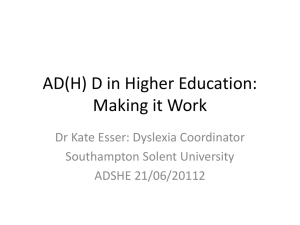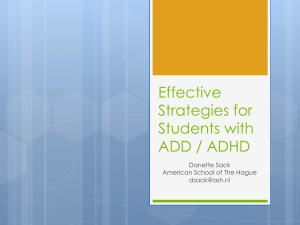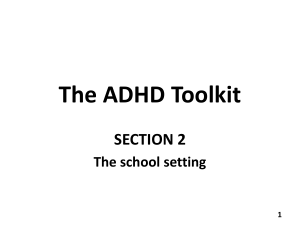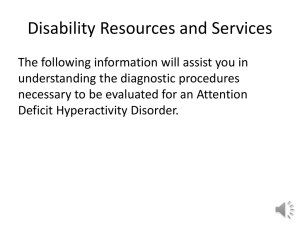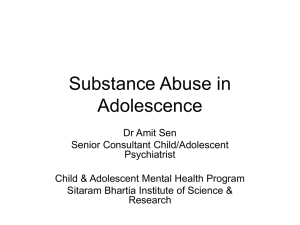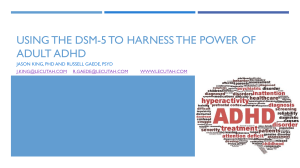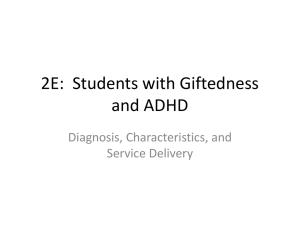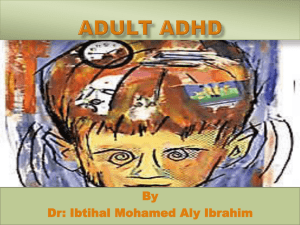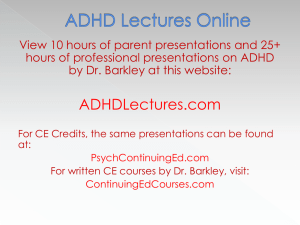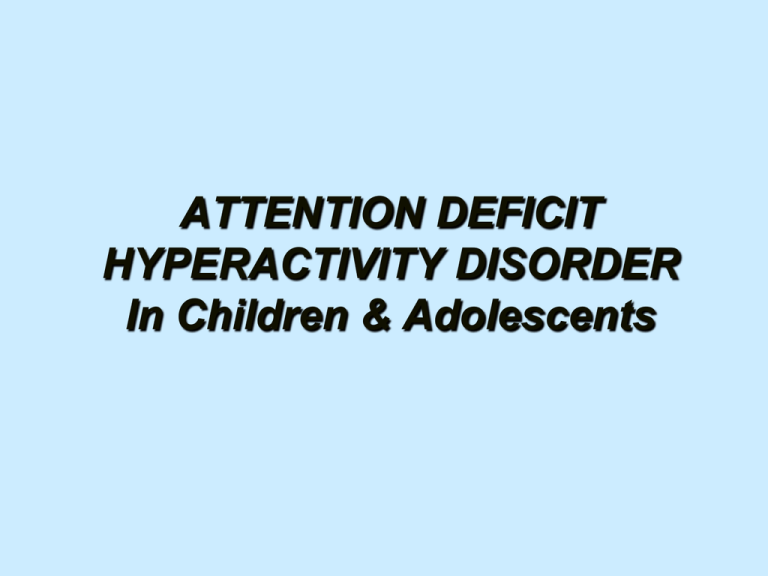
ATTENTION DEFICIT
HYPERACTIVITY DISORDER
In Children & Adolescents
What is ADHD?
The Current Clinical View
• A disorder featuring age-inappropriate :
– Inattention
• Poor persistence of responding
• Impaired resistance to distraction,
• Deficient task re-engagement following disruption
– Hyperactivity-Impulsivity (Disinhibition)
•
•
•
•
Impaired motor inhibition,
Poor sustained inhibition
Excessive and often task-irrelevant motor and verbal behavior
Restlessness decreases with age, becoming more internal, subjective by
adulthood
• Most cases are developmental and involve delays in the
rate at which these two traits are maturing
• Some cases are acquired (20%+; mainly males)
– These may represent pathology and may differ in severity, recovery, &
possibly treatment response
Essential Features
• ADHD presents as impairment in:
– Persistence
– Resistance to distraction
– Working memory
Persistence
• ADHD Individuals do not have problems with
such perceptual aspects of attention as:
– arousal or alertness
– focus or selective attention
– span of apprehension or divided attention
• Rather have an inability to sustain action
toward a goal for an adequate period of time
which is a motor problem
• Persistence is on the motor side of attention, it
is an output disorder.
• Output is the problem
• Most people think of attention as an input
problem: how you perceive, select filter and
process information
Resistance to Distraction
• Related to persistence: opposite sides of the
same coin.
• If you can persist it is because you can resist
distraction; If you can resist distraction you
can persist: One requires the other
• Not a perception problem, ADHD kids are not
“overly perceptive” they do not perceive
distractions any better the difference is that
they respond to the distracting events
• Most of us are able to inhibit our responses to
distracting events, ignore them even though
we detect them.
• ADHD is not a problem of perception but
inhibition
Working Memory
• Once distracted ADHD individuals are far less
likely to return to the original goal or task
• “task” re-engagement is a major problem for
this population
• This is modulated by working memory:
information held in mind that guides us toward
a goal.
• People with ADHD are likely to have serious
difficulties with working memory.
• Once distracted they are gone, off on another
task
Inattention Symptoms (DSM-IV)
Failure to give close attention to details
Difficulty sustaining attention
Does not seem to listen
Does not follow through on instructions
Difficulty organizing tasks or activities
Avoids tasks requiring sustained mental effort
Loses things necessary for tasks
Easily distracted
Forgetful in daily activities
Symptoms must occur “Often” or more frequently
Hyperactive-Impulsive Symptoms
Fidgets with hands or feet or squirms in seat
Leaves seat in classroom inappropriately
Runs about or climbs excessively
Has difficulty playing quietly
Is “on the go” or “driven by a motor”
Talks excessively
Blurts out answers before questions are
completed
Has difficulty awaiting turn
Interrupts or intrudes on others
Symptoms must occur “Often” or more frequently
DSM-IV Criteria for ADHD
• Manifests 6+ symptoms of either inattention or
hyperactive-impulsive behavior
• Symptoms are developmentally inappropriate
• Have existed for at least 6 months
• Occur across settings (2 or more)
• Result in impairment in major life activities
• Developed by age 7 years
• Are not better explained by another disorder,
e.g. Severe MR, PDD, Psychosis
• 3 Types: Inattentive, Hyperactive, or Combined
ADHD Varies by Setting
Better Here:
• Fun
• Immediate
• Frequent
• High
• Early
• Supervised
• One-to-one
• Novelty
• Fathers
• Strangers
• Clinic Exam Room
Worse Here:
Boring
Delayed Consequences
Infrequent Feedback
Low Salience
Late in the Day
Unsupervised
Group Situations
Familiarity
Mothers
Parents
Waiting Room
Prevalence (United States)
• 7-8% of children (using DSM-IV) (~3-4 million)
• Varies by sex, age, social class, & urban-rural
–
–
–
–
3:1 Males to females in children (5:1 in clinical samples)
Somewhat more common in middle to lower-middle classes
More common in population dense areas
No evidence for ethnic differences to date that are
independent of social class and urban-rural
Co-Occurring DSM-IV Disorders
•
•
•
•
•
•
•
More than 80% have one additional disorder
More than 60% have two additional disorders
Oppositional Defiant Disorder (Average of 55%)
Conduct Disorder (Average of 45%)
Anxiety Disorders (20-35%)
Major Depression (25-35%)
Bipolar Disorder (0-27%; likely 6-10% max.)
– (97% of those Diagnosed w/ Bipolar also have
ADHD)
Medical Risks
• Sleep problems (39-56%); mainly delayed
onset and greater night waking leading to
shorter sleep time
• Developmental Coordination Disorder (50+%)
• Reduced Physical Fitness, Strength, &
Stamina (using physical fitness tests)
• Accident Proneness 57%+
– 1.5 to 4x risk of injuries (greater in ODD)
– 3x risk for accidental poisonings
• Due to Impulsivity, risk-taking, impaired coordination,
oppositionality, and poor parental monitoring
Causes of ADHD
• Disorder arises from multiple causes
• All currently recognized causes fall in the
realm of biology (neurology, genetics)
• Causes may compound each other
• Common neurological pathway for ADHD
appears to be the areas of the brain
controlling Executive Functions and
Physical Activity (Smaller / Less
Developed)
• Social causes have poor evidence
Acquired Cases: Prenatal
• Maternal smoking in pregnancy (odds 2.5)
• Maternal alcohol drinking in pregnancy (same)
• Prematurity of birth, especially if brain bleeds
(45%+ have ADHD)
• Total increased pregnancy complications
• Maternal high phenylalanine levels in blood (?)
• High maternal anxiety in second trimester (?)
• Cocaine/crack exposure not a risk factor after
controlling for the above factors
Acquired Cases: Post-Natal (7-10%)
• Head trauma, brain hypoxia, tumors, or infection
• Lead poisoning in preschool years (0-3 yrs.)
• Survival from acute leukemia (ALL)
– Treatments for ALL cause brain damage
• Post-natal Streptococcal Bacterial Infection
– triggers auto-immune antibody attack of basal ganglia
• Post-natal elevated phenylalanine (dietary amino
acid related to PKU)
– Prenatal – hyperactivity
– Post-natal – inattention
Heredity – Family Studies
• Familial Expression of ADHD:
- 25-35% of siblings
- 78-92% of identical twins
- 15-20% of mothers
- 25-30% of fathers
- If parent is ADHD, 20-54% of offspring
(odds 8+)
Heredity – Twin Studies
• Heritability (Genetic contribution)
– 57-97% of individual differences (Mean 80%+)
– (91-95%+ using DSM criteria)
• Shared Environment (common to all siblings)
– 0-6% (Not significant in any study to date)
• Unique Environment (events that happen
only to one person in a family)
– 15-20% of individual differences
– (but includes unreliability of measure used to
assess ADHD)
Etiologies of ADHD
From Joel Nigg (2006), What Causes ADHD?
Other
Perinatal
Smoking
Lead
FASD
LBW
Heritable (Genetics)
Heritable
LBW
FASD
Lead (high)
Smoking
Perinatal
Other (Toxins)
ADHD Evaluation: Core
Considerations
• Are the symptoms of inattention, impulsiveness, and
overactivity, present. MOST Importantly Is there clear
evidence of an impulsive style?
• Is there evidence that these symptoms significantly
interfere with the child’s functioning both at school and at
home?
• Did these symptoms have a reasonably early onset? (If
not, is there a good explanation?).
• Have these symptoms been an enduring and consistent
feature of the child’s behavior throughout their
development and in the majority of contexts?
• Is there evidence that the child wishes to perform well but
cannot?
• Are there better explanations for the underachievement?
• Is there a pattern or specific triggers to the problem
behaviors?
6 Step Diagnostic Process
•
•
•
•
•
•
Review of Home Behavior
Review of School Bx and Collateral Information
Review of Developmental History
Review of Family/Marital Situation
School / Natural Environment Observation
Interview of Child
Psychodiagnostic Evaluation
• A psychodiagnostic Evaluation may be necessary if the
assessment produces mixed/inconsistent results or has
uncovered possible evidence of any of the following:
–
–
–
–
–
–
Suicidality
Significant Developmental Delays
Intellectual limitations
Learning disabilities
Serious Psychiatric disturbance
Significant family problems
• Other reasons to refer for testing:
–
–
–
–
–
Child was moderately to severely premature
Prenatal exposure to toxins especially ETOH & Nicotine
Low birth weight
Complicated pregnancy and/or birth
Reports that child had trouble grasping concepts/acquiring new
skills
– Reports that child has trouble with major academic subjects even
when attentive.
Ruling out Depression
• Later onset than ADHD
• Usually preceded by excessive anxiety
• Not uncommon to have both as a result of the
negative outcomes due to ADHD behaviors.
• Must treat both
• When comorbid, associated with a 4x increase
in suicidal ideation and 2x increase in attempts
• Appears to be connected to same genes
associated with ADHD.
• Best differential: EARLY HISTORY
Ruling Out Anxiety
• Onset later than ADHD
• Associated with a particular event or in
accordance with a time pattern (anniversary).
• Restlessness is not a primary manifestation of
Anxiety (usually a habit, style, or boredom)
• Usually characterized by panic or dread along
with worry.
• Best measure for presence of anxiety is child’s
report (parents and teachers under report).
Ruling Out PTSD
• Must look closely at developmental and early
school history.
• PTSD will stem from a specific event
• Children with ADHD are at greater risk for
PTSD from abuse and risky behaviors.
Ruling Out Bipolar Disorder
• Childhood BPD manifests as severe and
chronic irritability (rather than episodic mania)
• Also characterized by Disjointed thinking,
capricious mood, destructiveness, and
dysphoria.
• BPD usually starts as ADHD in childhood
• ADHD itself does not develop into BPD
• One-way Comorbidity
– 3-6% of ADHD have BPD
– 80-97% of BPD have ADHD
Ruling Out ODD
• In many cases ADHD is at the root of ODD
• There is a high degree of co-occurrence
• Early onset of ADHD symptoms is the
differential
Treating
ATTENTION DEFICIT HYPERACTIVITY
DISORDER
In Children & Adolescents
Current Perspective
• ADHD creates a kind of Myopia for future events
or “Time Blindness”.
• ADHD individuals live in the Moment
• ADHD is a Disorder of:
–
–
–
–
Performance, not skill
Doing what is known, not knowing what to do
The when & where, not the how or what
Using representations of the past at the appropriate
place & time (Point of Performance)
• ADHD is better characterized as an Intention
Deficit
ADHD & Executive Functioning
• Executive Functioning is responsible for two
types of sustained attention (SA):
– Contingency-shaped (Externally maintained)
• Video Games
– Goal-directed (Internally guided & motivated)
• Homework
• Goal-directed (SA) is impaired in ADHD
individuals which creates problems with:
– Delayed responding & intrinsic motivation
– Doing the opposite of what is suggested in sensory
fields
– Time, waiting, delays, and future orientation
– Problem solving, strategy development, & flexibility
• Increases in complexity with age & development
Treatment Implications
• Teaching skills is ineffective (As is insight)
• Treatment must occur at the point of performance.
• Medications are likely to be essential for most but
not all cases.
• Diminished capacity does not excuse accountability
(The problem is time and timing not consequences).
• Behavioral treatment is essential but does
generalize or endure after removal.
• Treatment success depends on the compassion and
willingness of others to make accommodations.
• Maintaining a “Chronic Disability” perspective is
most effective.
Unproven / Disproved Therapies
• Elimination Diets: Sugar, Additives, etc. (Weak
Evidence)
• Megavitamins, Anti-oxidants, Minerals: (No strong
evidence or disproved)
• Sensory Integration Training (Disproved)
• Chiropractic Skull Manipulation (No Evidence)
• Play / Psychotherapy (Disproved)
• Neurofeedback (Experimental)
• Cognitive Self-Control Therapies (Effective in Clinic)
• Social Skills Training (Effective in Clinic Setting)
– Better for Inattentive (SCT) Type and anxious cases
Empirically Proven Treatments
• Parent Education
• Psychopharmacology
• Parent Training in Child Management
– 65-75% of Children under 11 respond
– 25-30% of Adolescents show reliable changes
• Family Therapy for Adolescents:
– Problem-Solving and Communication Training
– 30% show change (best combined with BMT)
• Teacher Education
• Train Teachers in Classroom Bx Management
• Special Ed (IDEA, 504)
• Regular Physical Exercise
• Residential Treatment (5-8%)
• Parent Family Services (25+%)
• Parent/Patient Support Groups
Managing ADHD
• Time is critical: reduce delays
• Externalize a many processes as possible:
– Time (Clocks, Timers, Calendars, PDAs etc.)
– Important information (Lists, reminders, instruction
cards, etc.)
– Motivation (Token economy, tangible rewards)
– Problem Solving (use paper and pencil or dry erase
board)
•
•
•
•
Give immediate feedback
Increase frequency of consequences
Increase accountability to others
Use salient & artificial rewards
General Recommendations
• Change rewards periodically
• Minimize talking, maximize communicative
touch
– Corollary: “Act don’t Yak”
• Maintain a sense of humor
• Emphasize rewards over punishments (reward
first)
• Anticipate problem situations and make a plan
• Keep a sense of priorities (pick your battles)
• Hold to the perspective of ADHD as a Disability
• Be forgiving (of child, self, and others)
Give Effective Commands
•
•
•
•
•
•
Initially give heavy praise to high compliance commands
Don’t use questions, use Imperatives
Use eye contact and touch
Have child recite request
Break complex tasks into simpler ones
Make chore cards for Multi-Step tasks
– List all steps involved on a 3x5 card
– Stipulate the time period on the card
•
•
•
•
•
•
Reduce time delays for consequences
Make use of Timers at the Point of Performance
Avoid assignment of multiple tasks all at once
Praise initiation of compliance
Provide rewards throughout the task
Have child evaluate their performance at the end
Time-Out
•
•
•
•
Target time-out to focus on one problem
Act quickly after infractions
Violations of household rules get instant time out
Immediate commands:
– Give Command ( count backwards from 5)
– Give Warning with raised voice (repeat count of 5)
– Initiate time-out
• Release from time-out contingent on:
– Completion of minimum time period (1-2 minutes/year of age)
– Becoming quiet
– Consenting to command
• Reward next good behavior
• Best to use Bedroom for Time-out
– Remove all major play activities (Sanitize)
Psychopharmacology
Stimulant Medications
• These are the most well studied drugs in psychiatry
– In use for over 40 years
– Over 350 studies
– Thousands of cases
Stimulant
Response Rate
Ritalin (Methylphenidate)
77%
Adderall (Amphetamine)
74%
Dexedrine
(Dextroamphetamime)
73%
Trying All
90%
Stimulants:
Behavioral Effects
•
•
•
•
•
•
•
•
•
•
•
•
•
Increased concentration and persistence
Decreased Impulsivity & hyperactivity
Increased work productivity
Better emotional control
Decreased aggression and defiance
Improved compliance
Better working memory & internalized language
Improved handwriting and motor coordination
Improved self-esteem
Decreased punishment
Improved peer acceptance and interactions
Better awareness in sports
Improved driving performance
Stimulants: Side Effects
• Most tolerate well
– 5% discontinue due to negative effects
• Side effects are dose dependent
• Most common side effects:
–
–
–
–
Insomnia (50% +)
Loss of Appetite (50% +)
Headaches (20-40%)
Stomach Aches (20-40%)
• Irritability, tearfulness (<10%)
• Nervous Habits & Mannerisms (<10%)
– Tics (<3%) and Tourette’s (Rare)
• Mild Weight Loss (Average 1-4 pounds; transient)
• Small effect on height during 1st year (Approx 1cm)
Increased heart rate (3-10 bpm)
• Increased blood pressure (1.5-14 mmHg)
• Psychosis (<3%)
Stimulants:
Common Myths
• Addictive when used as prescribed
– No, Must be inhaled or injected
• Over Prescribed
– 7.8% prevalence rate, only 4.3% on stimulants
• Creates Aggressive, Assaultive Behavior
– No, decreases aggression and antisocial actions
• Increases the likelihood of Seizures
– Only at very very high doses
• Causes Tourette’s Syndrome
– Can increase tics in 30%; decreases it in 35%
• Increases risk of later substance abuse
– No, 14 studies have found no such result, some found that it
decreased risk if continued throughout teens
Strattera
•
•
•
•
•
•
•
•
Selective Norepinepherine reuptake inhibitor
Not Schedule II; no abuse potential
Effective for children, adolescents, and adults
Equal efficacy with Methylphenidate with
previously unmedicated cases (75% positive
response)
Slightly lower efficacy with those previously on
stimulants (55% positive response)
Sustained response for up to 3 years
Increasing improvement over time
Can be given once daily (morning) or split
(am/pm)
Benefits of Strattera
•
•
•
•
•
•
•
•
•
Reduces ADHD, ODD, & aggression
Reduces internalizing symptoms
Increases school productivity
Improved peer social behavior
Improved self-esteem
Improved parent-child relations
Improved dry nights among bed-wetters
Better “morning after” behavior
Less insomnia and faster onset of sleep than
Methylphenidate
• No emotional blunting
Academic and Occupational
Interventions for the
Treatment of ADHD
Classroom Management:
Basic Considerations
• One of the major impairments of children with
ADHD is functioning in the educational setting.
• More children with ADHD are receiving services in
public schools now than at any other time in
history.
• Despite the success of medication management
and parent training, psychoeducational
interventions are needed to ensure academic
success and maintain positive behavior in children
with ADHD.
Classroom Management:
Basic Considerations
• The first goal of school-based interventions is to
improve basic knowledge among educators
about the nature, causes, course and treatment
of ADHD.
• The second goal is to increase home and
school collaboration to ensure that the
treatment plan is consistent, and effective
across settings.
• Third, effective interventions should include
strategies to improve academic and social
functioning in children and adolescents and
occupational functioning in adults.
ADHD Basics:
Training for Educators
• ADHD is biologically based and is treatable but
not curable. Goal is to manage symptoms and
reduce secondary harm (e.g., grade retention,
peer rejection, disciplinary actions).
• ADHD is not due to a lack of skill or knowledge,
but is a problem of sustaining attention, effort,
and motivation and of inhibiting behavior. It is a
disorder of performing what one knows, not of
knowing what to do.
• Treatment is most effective when applied
consistently at the place and time where a
behavior is expected to be performed (e.g., at
school).
ADHD Basics:
Training for Educators
• It is harder for students with ADHD to do the
same academic work and exhibit the social
behavior expected of other students. Thus, these
students need more structure, frequent positive
consequences, consistent negative
consequences, and accommodations to assigned
work.
• To maximize behavior change: proactive
interventions involve manipulating antecedent
events to prevent challenging behaviors from
occurring; reactive interventions involve
implementing consequences following a target
behavior.
Classroom Interventions :
9 Key Principles
• Rules and instructions provided to children
with ADHD must be clear, brief and often
delivered through more visible and external
modes of presentation than required for the
management of their peers.
• Consequences used to manage the behavior
of those with ADHD must be delivered more
swiftly (ideally, immediately) than with their
peers.
• Consequences must also be applied more
frequently.
Classroom Interventions :
9 Key Principles
• Consequences must often be of a higher
magnitude, or more powerful, than that
needed to manage the behavior of typical
children.
• An appropriate degree of incentives must
be provided within a setting or task to
reinforce appropriate behavior before
punishment can be implemented.
• Reinforcers/rewards that are employed must
be changed or rotated more frequently than
typical to avoid habituation or satiation.
Classroom Interventions :
9 Key Principles
• Anticipation is key. Thus, teachers must
plan ahead and ensure that children with
ADHD are cognizant of an upcoming
transition or change in rules or routine before
it occurs. “Think aloud, think ahead.”
• Children with ADHD must be held more
publicly accountable for their behavior and
goal attainment than typical children.
• Behavioral interventions only work while they
are being implemented and require
modification over time for effectiveness.
Classroom Management:
Accommodations
• 10 core areas of intervention:
–
–
–
–
–
–
–
–
–
–
Decrease workload to fit the child’s attentional capacity
Alter teaching style and curriculum
Make rules external
Increase frequency of rewards and fines
Increase immediacy of consequences
Increase the magnitude/power of rewards
Set time limits for work completion
Develop a hierarchy of classroom punishments
Coordinate home and school consequences
Modifications for teens & adults
Classroom Management:
Accommodations
• Decreasing the workload
– Give smaller quotas of work
– Allow frequent, shorter work periods
– Target productivity and effort first; accuracy and
completion of assignments later
– Post work instructions on the board; provide a schedule
of assignments weekly and send home to parents.
– Reduce the amount of homework to 10 mins. per grade
level (e.g., 1st grade= 10 mins.)
Classroom Management:
Accommodations
• Modifying the classroom and curriculum
– Be animated, flexible and responsive
– Reward incentive systems and clear
consequences for misbehavior are crucial
– Use participatory teaching strategies: have child
write on board, point, use counters
– Sit child close to the teacher’s area
– Allow for restlessness, short stretching and/or
exercise breaks
– Intersperse low interest with high interest tasks
Classroom Management:
Accommodations
• Make rules external
– Post schedule and rules
– Use color-coded materials for instructions
and organization
– Have child re-state the instruction to
ensure understanding
– Use verbal prompts such as “stay in seat,”
“keep on working,” etc.
Classroom Management:
Accommodations
• Use a reward incentive system
– Combine positive consequences (praise,
rewards, token economies) and negative
consequences (response cost, time out),
with positive consequences tending to
make the most impact
– Use strategic teacher attention: smiles,
nods, pats on the back, active ignoring
Classroom Management:
Accommodations
• Consequences must be immediate
– Avoid lengthy reasoning over misbehavior.
Simply state the misbehavior and the
consequence (should be posted as a rule)
– Use a daily report card or sticker chart.
– Variations of time out: go to the “chill area” of
classroom; complete a given number of
worksheets (drills) depending on the severity of
the misbehavior
– Use mild, private, specific reprimands although
punishment should be used sparingly
Classroom Management:
Accommodations
• Rewards must be tangible and desirable
– Vary rewards to keep interest high
– A videogame (especially, educational type) or
computer program can be used as an incentive
– Have parents donate preferred toys and games
– Try group rewards
– Use a home-school based reward program (e.g.
good behavior points from school transfer to
rewards at home)
Classroom Management:
Accommodations
• Set time limits for work completion
– Use timers or a bell to signify the end of a
work period; use a signal about five
minutes before the end as well
– Generally, “extra time” is not beneficial.
Focus on developing a distraction-free
work setting and provide breaks after short
work periods.
Classroom Management:
Accommodations
• Use a punishment hierarchy
– Head down on desk; quiet time
– Response cost (loss of tokens)
– Time out in a corner/”chill” location
– Time out at school office where child’s
behavior can be monitored
– Suspension to the office (in school, not at
home)--punishment is immediate and brief
and does not include rewarding activities
Classroom Management:
Accommodations
• Coordinate home and school
consequences
– Daily school behavior report card/rating
form and point system
– Daily home-school journal to communicate
with parents and/or provide a reminder to
child when completing homework
– Gradually, move to weekly monitoring
Classroom Management:
Accommodations
• Specifically, for teens with ADHD:
– Use a daily assignment notebook/planner with teacher
verification and cross-checking
– Create a private, in-class cueing system for off-task
behavior and disruption
– Use a daily or weekly school report card; coordinate w/
home rewards (e.g. $ for grades)
– Assign a daily case manager or organizational coach to
help monitor, organize and motivate
– Permit music during homework
– Require note-taking to pay attention
– Keep an extra set of books/materials at home
Classroom Management:
Accommodations
• More tips for teens:
– Learn SQ4R for reading comprehension:
Survey material, draft Questions, Read, Recite,
Write, Review
-- Study with buddy after school
-- Swap phone numbers and email addresses with
classmates to call in the event of lost or missing
assignment sheets and instructions
-- Attend after school help/tutoring sessions
-- Schedule parent-teacher review meetings every
6 weeks
Occupational:
Accommodations
• College-bound teens and young adults may
require assistance with:
– Employment
– Independent Living
– Managing money
– Organization
– Time management
– Accommodations/resources for college and
occupational success
Occupational:
Accommodations
• CHADD (Children and Adults with Attention-
Deficit/Hyperactivity Disorder) offers several
resources to assist adults in handling these
and other important issues. Please visit
www.chadd.org for more information.
Summary
• Education of teachers and other professionals
working with children and adults with ADHD is
crucial to helping these individuals receive the
accommodations needed to ensure success
academically and occupationally.
• Interventions are effective as long as they are
being implemented and must be maintained over
extended time periods.
• Collaboration between school and home appears
to ensure greater success in the classroom.
• There are many resources available offering a
wealth of advice to professionals who help those
with ADHD.
Resources
• www.chadd.org offers scientifically reliable information in English and
Spanish about ADD in children, adolescents, and adults. Sponsored by
Children and Adults with ADHD (CHADD), the largest ADHD support and
advocacy organization in the United States, it has downloadable fact sheets of
science-based information for parents, educators, professionals, the media,
and the general public. The site also includes contact information for two
hundred local chapters of CHADD throughout the United States.
• www.help4adhd.org presents evidence-based information in English and
Spanish about ADD in children, adolescents, and adults. This national clearing
house of downloadable information and resources concerning many aspects
of ADHD is funded by the U.S. government's Centers for Disease Control and
Prevention and operated by CHADD. New material is added frequently, and
questions directed to the site are responded to by knowledgeable healthinformation specialists.
• www.add.org is a resource in English for adults with ADD. Sponsored by
Attention Deficit Disorder Association (ADDA), the world's largest organization
for adults with ADHD, it provides information, resources, and networking
opportunities.

